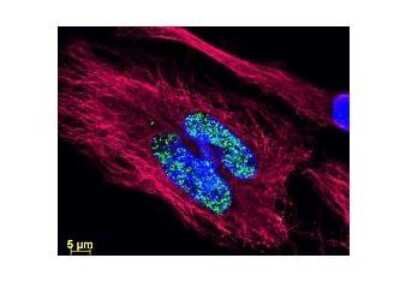Goat anti-Hamster IgG (H+L) Secondary Antibody [DyLight 488] (Pre-adsorbed)
Novus Biologicals, part of Bio-Techne | Catalog # NBP1-73008


Forumulation
Catalog #
Key Product Details
Species Reactivity
Hamster
Applications
Fluorophore-linked immunosorbent assay, Immunocytochemistry/ Immunofluorescence, Immunohistochemistry, Immunohistochemistry-Paraffin, Western Blot
Label
DyLight 488 (Excitation = 493 nm, Emission = 518 nm)
Antibody Source
Polyclonal Goat IgG
Format
Pre-adsorbed
Concentration
LYOPH mg/ml
Product Specifications
Immunogen
Armenian and Golden Syrian Hamster IgG, whole molecule
Reactivity Notes
Cricetulus migratorius (Armenian Hamster); Melanochromis auratus (Golden Syrian Hamster)
Specificity
This antibody was pre-adsorbed against Mouse and Rat Serum Proteins. No reaction was observed against Mouse or Rat Serum Proteins. This antibody will react with heavy chains of Golden Syrian & Armenian Hamster IgG and with light chains of most Golden Syrian & Armenian Hamster immunoglobulins.
Clonality
Polyclonal
Host
Goat
Isotype
IgG
Description
Store vial at 4C prior to restoration. For extended storage aliquot contents and freeze at -20C or below. Avoid cycles of freezing and thawing. Centrifuge product if not completely clear after standing at room temperature. This product is stable for several weeks at 4C as an undiluted liquid. Dilute only prior to immediate use.
This product was prepared from monospecific antiserum by immunoaffinity chromatography using Golden Syrian & Armenian Hamster IgG coupled to agarose beads followed by solid phase adsorption(s) to remove any unwanted reactivities. Assay by immunoelectrophoresis resulted in a single precipitin arc against anti-Goat Serum, Golden Syrian & Armenian Hamster IgG and Golden Syrian & Armenian Hamster Serum
This product was prepared from monospecific antiserum by immunoaffinity chromatography using Golden Syrian & Armenian Hamster IgG coupled to agarose beads followed by solid phase adsorption(s) to remove any unwanted reactivities. Assay by immunoelectrophoresis resulted in a single precipitin arc against anti-Goat Serum, Golden Syrian & Armenian Hamster IgG and Golden Syrian & Armenian Hamster Serum
Scientific Data Images
Immunocytochemistry/Immunofluorescence: Goat anti-Hamster IgG (H+L) Secondary Antibody [DyLight 488] (Pre-adsorbed) [NBP1-73008] - This image shows anti-histone detection using a DyLight 488 conjugate (green). Anti-Tubulin was detected using a DyLight 549 conjugate (red). Nuclei were counter-stained using DAPI (blue). The image was captured using an Axio Imager.Z1 (Zeiss Micro Imaging Inc).
Applications
Application
Recommended Usage
Fluorophore-linked immunosorbent assay
1:20000
Immunocytochemistry/ Immunofluorescence
1:5000
Immunohistochemistry
1:200 - 1:500
Immunohistochemistry-Paraffin
1:200 - 1:500
Western Blot
1:10000
Application Notes
This product has been tested by western blot and is designed for immunofluorescence microscopy, fluorescence based plate assays (FLISA) and fluorescent western blotting. This product is also suitable for multiplex analysis, including multicolor imaging, utilizing various commercial platforms. The emission spectra for this DyLight(TM) conjugate match the principle output wavelengths of most common fluorescence instrumentation.
Formulation, Preparation, and Storage
Purification
Multi-step
Reconstitution
Reconstitute with 100 ul deionized water (or equivalent).
Formulation
Lyophilized from 0.02 M Potassium Phosphate, 0.15 M Sodium Chloride, pH 7.2, 10 mg/mL Bovine Serum Albumin (BSA) - Immunoglobulin and Protease free
Format
Pre-adsorbed
Preservative
0.01% Sodium Azide
Concentration
LYOPH mg/ml
Shipping
The product is shipped with polar packs. Upon receipt, store it immediately at the temperature recommended below.
Stability & Storage
Store lyophilized antibody at 4C in the dark. Aliquot reconstituted liquid and store at -20C. Avoid freeze-thaw cycles.
Background: IgG (H+L)
The 4 IgG subclasses, sharing 95% amino acid identity, include IgG1, IgG2, IgG3, and IgG4 for humans and IgG1, IgG2a, IgG2b, and IgG3 for mice. The relative abundance of each human subclass is 60% for IgG1, 32% for IgG2, 4% for IgG3, and 4% for IgG4. In an IgG deficiency, there may be a shortage of one or more subclasses (4).
References
1. Painter RH. (1998) Encyclopedia of Immunology (Second Edition). Elsevier. 1208-1211
2. Chapter 9 - Antibodies. (2012) Immunology for Pharmacy. Mosby 70-78
3. Schroeder H, Cavacini, L. (2010) Structure and Function of Immunoglobulins. J Allergy Clin Immunol. 125(2 0 2): S41-S52. PMID: 20176268
4. Vidarsson G, Dekkers G, Rispens T. (2014) IgG subclasses and allotypes: from structure to effector functions. Front Immunol. 5:520. PMID: 25368619
Additional IgG (H+L) Products
Product Specific Notices
DyLight (R) is a trademark of Thermo Fisher Scientific Inc. and its subsidiaries.
This product is for research use only and is not approved for use in humans or in clinical diagnosis. Secondary Antibodies are guaranteed for 1 year from date of receipt.
